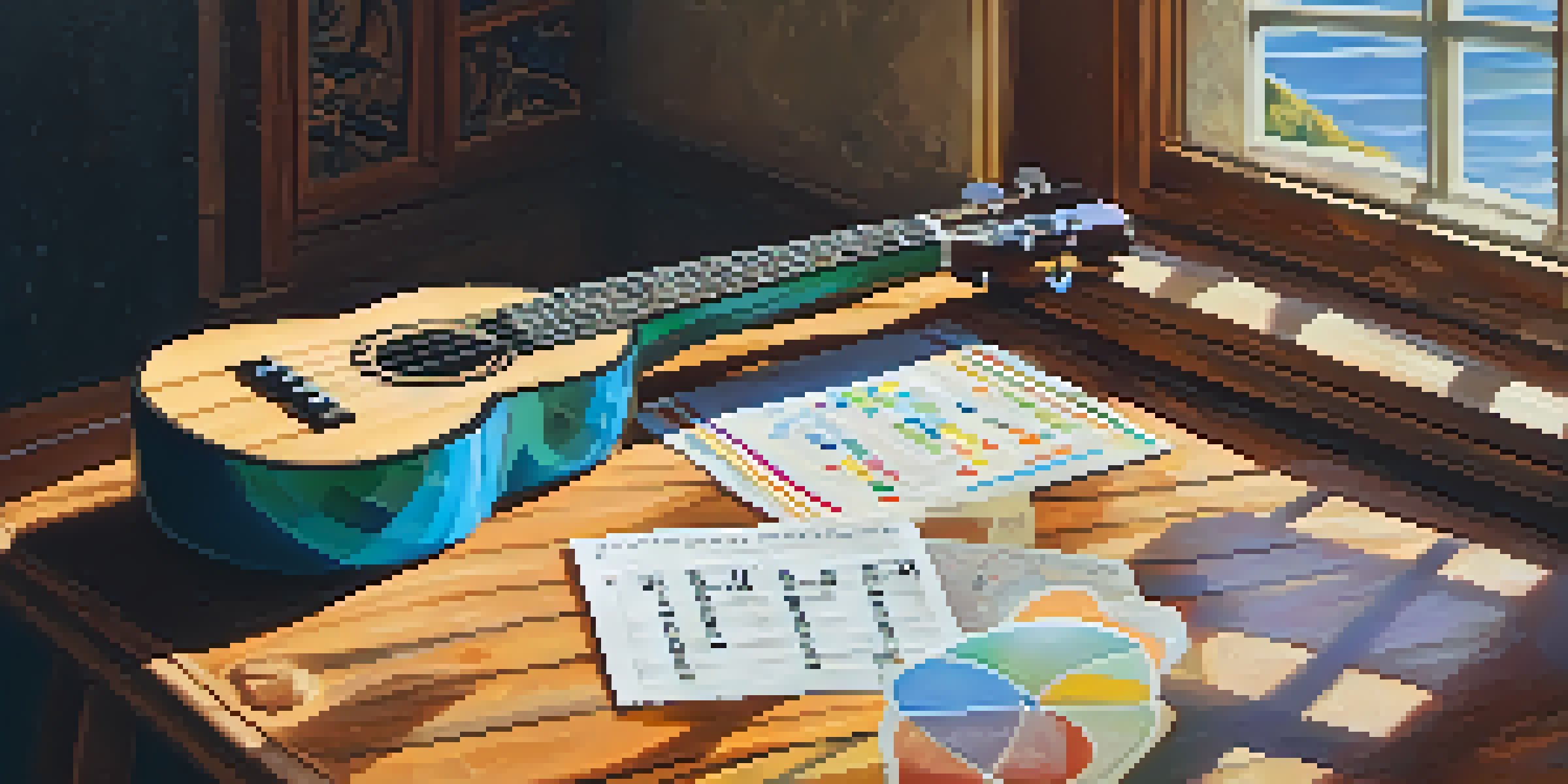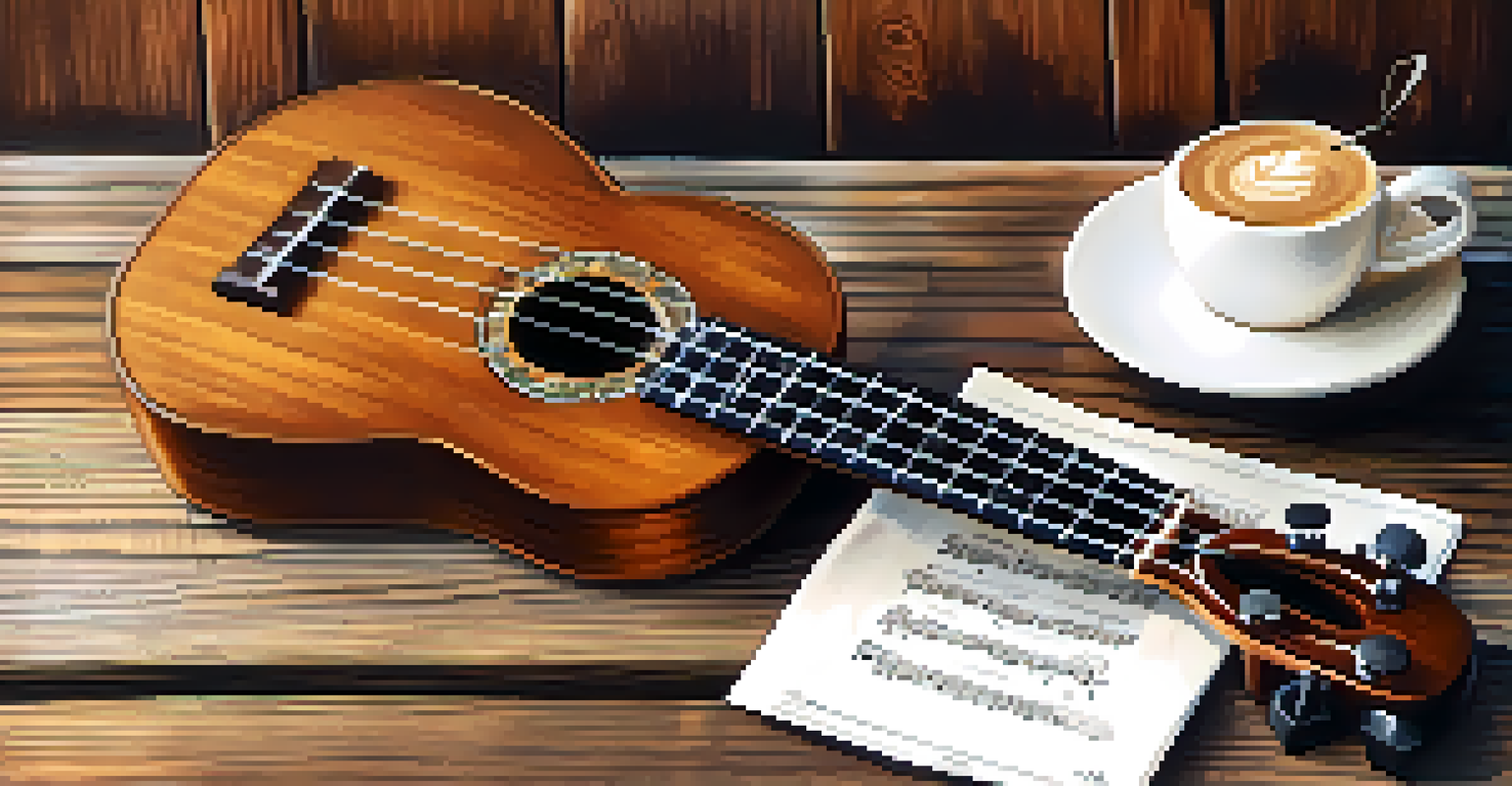Essential Ukulele Chords for Beginners to Start Playing Now

Why Learning Ukulele Chords is Important for Beginners
Starting your musical journey with the ukulele is exciting, and mastering chords is your first step. Chords are the building blocks of songs, allowing you to accompany yourself and others. By learning just a few basic chords, you can play countless songs and quickly build your confidence.
The beautiful thing about learning is that no one can take it away from you.
The ukulele is a friendly instrument, often regarded as one of the easiest to learn. Its four nylon strings are gentle on your fingers, making it perfect for beginners. This accessibility means that with some practice, you’ll be strumming along to your favorite tunes in no time.
Additionally, understanding chords opens up a world of musical possibilities. Once you grasp the essentials, you can explore different genres and even write your own music. This foundational skill not only enhances your playing but also enriches your overall musical experience.
The Basic Chords Every Ukulele Player Should Know
As a beginner, there are a few essential chords that will serve you well. The most common ones include C, G, F, and Am. These chords are the backbone of many popular songs, meaning they will allow you to play music that you love right from the start.

For example, the C chord is often the first chord new players learn because it's easy to play—just one finger on the third fret of the bottom string. Similarly, G and F chords are also straightforward and commonly used in many songs, making them valuable additions to your repertoire.
Importance of Learning Ukulele Chords
Mastering basic chords is essential for beginners as it enables them to play a wide range of songs and boosts their confidence.
Once you’ve mastered these basic chords, you can start to combine them into simple progressions. This combination will enable you to strum along to many of your favorite songs, boosting your enjoyment and encouraging practice.
Learning to Play the C Chord: Your First Step
The C chord is often the first chord every ukulele player learns. To play it, place your ring finger on the third fret of the A string (the bottom string). Strum all four strings, and you should hear a bright, cheerful sound that will put a smile on your face.
Music can change the world because it can change people.
To practice, try switching between the C chord and other chords you’re learning. This will help you develop your finger strength and dexterity. You can also play simple songs that use the C chord, reinforcing your skills and making learning fun.
As you become comfortable with the C chord, you'll realize how it serves as a gateway to more complex chords. The confidence gained from playing the C chord will motivate you to tackle the next ones, propelling your musical journey forward.
Mastering the G Chord for Smooth Transitions
Once you're confident with the C chord, it's time to tackle the G chord. To play it, you need to use your index, middle, and ring fingers to press down on the second fret of the C string, the third fret of the E string, and the second fret of the A string, respectively. It may feel tricky at first, but don’t worry; practice makes perfect.
A great way to practice the G chord is by switching back and forth between it and the C chord. This exercise helps you get used to moving your fingers quickly and builds muscle memory. You’ll notice that with repetition, your transitions will become smoother and faster.
Essential Chords for Beginners
C, G, F, and Am are fundamental chords that serve as the foundation for many popular songs, making them crucial for new players.
The G chord opens up many song options, as it’s frequently used in popular music. From classic hits to contemporary favorites, mastering this chord will enhance your ability to play along with others, making your sessions even more enjoyable.
Getting Comfortable with the F Chord
The F chord is another essential chord that is relatively easy to learn. To play it, place your index finger on the first fret of the E string and your middle finger on the second fret of the G string. Strum all four strings, and you’ll produce a lovely, harmonious sound.
Practicing the F chord alongside the C and G chords will create a solid foundation for many chord progressions. A common practice is to strum C, then F, then G, and back to C. This will not only help you with finger placement but also with timing and rhythm.
As you become more comfortable with the F chord, you'll find that it adds depth to your playing. It allows you to express different emotions in your music, making your performances more engaging and enjoyable for both you and your audience.
Exploring the Am Chord for Added Variety
The Am chord, or A minor chord, is a great addition to your beginner toolkit. To play it, simply place your middle finger on the second fret of the G string and strum all four strings. The sound it produces adds a touch of melancholy that can enhance your music's emotional quality.
One fun way to practice the Am chord is by integrating it into the chord progressions you’ve already learned. For instance, try switching between C, Am, and F. This will challenge your fingers and improve your overall playing fluidity.
Effective Practice Tips
Consistent practice, using a metronome, and having fun are key strategies to enhance your chord-playing skills and keep motivation high.
The Am chord is also a staple in many popular songs, making it useful for those looking to expand their repertoire. As you incorporate it into your practice, you'll gain confidence and discover new musical landscapes to explore.
Tips for Practicing Chords Effectively
To get the most out of your practice sessions, consistency is key. Set aside a little time each day to work on your chords, even if it’s just 10-15 minutes. This approach will help build your muscle memory and make transitions smoother over time.
Another effective tip is to use a metronome or backing track while practicing. This will help you keep a steady rhythm and develop your timing, which are crucial for playing along with others. The goal is to sound good, and rhythm plays a massive role in that.

Finally, don’t forget to have fun! Experiment with different strumming patterns and try playing along with songs you enjoy. The more you enjoy your practice, the more motivated you will be to continue learning and improving.
Putting It All Together: Playing Your First Song
Now that you’ve learned some essential chords, it’s time to put them into action by playing your first song. Choose a simple song that uses the chords C, G, F, and Am. Many popular songs are based on these chords, so you'll have plenty of options to choose from.
Start by playing each chord slowly, ensuring that your finger placements are correct. Once you’re comfortable, try to play along with the song, gradually increasing your speed as you get more confident. Don’t be discouraged if it takes a few tries; practice is all part of the process!
Playing your first song is incredibly rewarding and a significant milestone in your musical journey. Celebrate this achievement, and remember that each song you learn will only add to your skills and enjoyment of the ukulele.